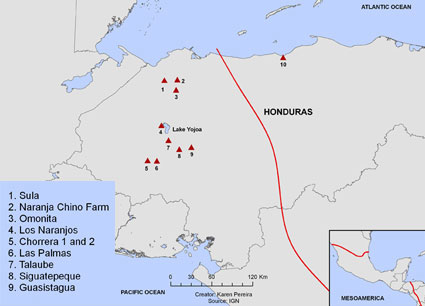The Honduras Ceramic Collection
 The Honduras Collection was donated to the Florida Museum of Natural History (FLMNH) in 1929 and 1930 by G.W. Van Hyning and the N. Geraci Fruit Company, a Banana Company operating in Honduras during the 1930s. Most of the specimens were collected by G.W. Van Hyning who was related to Thompson Van Hyning the first director of the FLMNH. The collection of sherds is relatively small (over 5,000 sherds) but covers a wide geographical area, making it a useful research collection.
The Honduras Collection was donated to the Florida Museum of Natural History (FLMNH) in 1929 and 1930 by G.W. Van Hyning and the N. Geraci Fruit Company, a Banana Company operating in Honduras during the 1930s. Most of the specimens were collected by G.W. Van Hyning who was related to Thompson Van Hyning the first director of the FLMNH. The collection of sherds is relatively small (over 5,000 sherds) but covers a wide geographical area, making it a useful research collection.
Honduras marks the southern border line of Mesoamerica as originally defined by Paul Kirchoff in 1943. This makes Honduras an interesting place to study the cultural interaction between Mesoamerica and lower Central America, considered to be part of a larger zone called the Intermediate Area extending into South America (Lara Pinto 1996). Recent research indicates considerable cultural diversity in Honduras, including both Maya cultures such as those found around the area of Copan and Non-Maya cultures, and others that indicate a blend of both (Beaudry-Corbett and Henderson 1993; Drennan 1996).
Honduras Collection sites
The Honduras Collection contains specimens from fourteen archaeological sites.* After Beaudry-Corbett and Henderson 1993
About half of the specimens from the Honduras Ceramic Collection come from the Northeastern Region of Honduras from the sites of Balfate and Bamboo. Both sites are part of the northeastern ceramic tradition which depicts several iconographic motifs related to the Manatee Tradition (Cuddy 2007). Balfate marks the western extreme of the northeast ceramic tradition in the Cocal period (AD 1000 – 1400), represented by a local variation of Manatee ceramics that also extended to the Honduras Islands, contemporary with Mesoamerican’s Early and Late Postclassic periods (Cuddy 2007:70-3, 156). Bamboo, also known as 80 Acre Village or Stuart’s Hill, is dated to the Transitional Selin phase during the Late-Terminal Classic period (Cuddy 2007:156).
The Balfate and Bamboo collection includes several lug fragments decorated with fine incisions. The main characteristic of such specimens is a hollow elongated prong with a narrow tip at the end of the lug. The collection also presents leg decorations of appliqué and/or finger pinched nodes which may represent either humanoid faces or animal faces.
Fragments similar to the ones in the FLMNH collection are catalogued as Dorina Incised at other sites in Northeastern Honduras (Healy 1993:209-10). Other related sherds are documented in the Anthropology Collection Database through the NMNH Smithsonian Catalogue Online and the Peabody Online Collection.
Dorina Abstract Incised is represented with an exterior decoration of lazy S or abstracted curvilinear scroll lines, usually incised and offset by punctuation or jab marks, smoothed and lightly spilled surface, shallow tripod bowls and plates and frying pan censers, composite silhouette vessels, elaborate hollow supports and lugs, often with incised decoration, solid grooved, and conical legs (Healy 1993:211-12)
Another small but significant component from Honduras at the FLMNH are the polychrome fragments from the Yojoa Region and Lower Ulúa Region, which include specimens from the sites of Los Naranjos, Talaube, Plowden, Sula, Naranjo Chino Farm, and Omonita. According to Viel (1977) the Ulua-Yojoa polychrome tradition is dated to the Late Classic period (AD 600 – AD 900).
This ceramic tradition is composed of polychrome vessels with elaborate designs in red, orange, and black pigments. These designs tend to be abstract and include well known designs also found in the Maya ceramic tradition to the north, such as the mat motif, S-shapes, step frets, chevrons, and scales. Zoomorphic and anthropomorphic figures are depicted as the central components of several vessels. Lug handles with animal decorations are also part of this tradition (Henderson and Beaudry-Corbett 1993).
The remainder of the ceramic collection comes from the southwestern sites of Guasistagua, La Chorrera #1, La Chorrera #2, Siguatepeque, and Las Palmas. Unfortunately, most of these sherds are so eroded they cannot be dated to a specific time period or a ceramic style.